IGUANAS
 Modrý Iguana |  Albino Iguana |
|---|---|
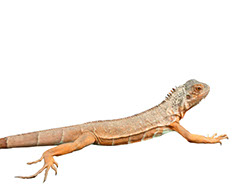 Red Iguana | 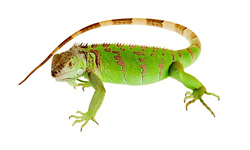 Green Iguana |
Iguana Care Sheet
Veľkosť: Dospelí leguány túlajú sa vo veľkosti od štyri až šesť stôp na dĺžku.
Životnosť: Ak je riadne postarané, leguány by žije viac ako 20 rokov v zajatí.
Celkový vzhľad: Leguány sú to, čo väčšina ľudí myslí, keď si myslia, že "jašterica". Majú päť prstov na každej nohe. Majú mäsitý kožu záhyb pod bradou volal lalok. Všetky leguány majú ostne, ktoré beží po celej dĺžke chrbta. Na rozdiel od všeobecného presvedčenia, nie všetky leguány sú zelené. Väčšina mladiství sú sýto zelené, ale ako starnú, a rast sa môžu pohybovať v farbe od jednotvárny zelenej až hnedé alebo dokonca oranžové s pruhovanými chvosty.
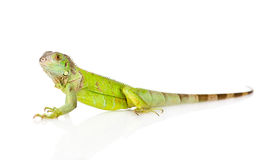
Požiadavky na bývanie
Príloha: Puzdro pre dospelého leguána je veľmi veľký. Kryt by mala byť najmenej šesť stôp vysoký, asi 1
Teplota: Leguáni pochádzajú z tropickej klíma a musí byť v teple. Denné teploty by mali byť 80.
Je potrebná Ultrafialové osvetlenie poskytujúce UVA a UVB pre správny metabolizmus vápnika a vývoj kostry: Heat / Light. Bez správne osvetlenie vaše stane chorý a umiera veľmi bolestivou smrťou. Správne osvetlenie môžu byť poskytované s použitím žiarivky špeciálne vyrobené pre použitie plazy, rovnako ako ortuťové žiarovky, ktoré poskytujú tiež určité množstvo tepla, ako. Ďalšie teplo môže byť poskytnutá s použitím infračervenej keramické vysielača a žiarovkové vyhrievajú žiarovky. Horúce kamene by nikdy nemali byť používané za žiadnych okolností, pretože môže vážne spáliť leguán.

Podklad: Leguáni často jazyk lízať svoje okolie. Vzhľadom k tejto najviac častíc substrátu (drevené hobliny, kompost, piesok, alebo typy práškových), nie sú vhodné pre väčšinu leguány. Noviny s nezávadnou farbou, papier mäsiara, papierové uteráky, vnútorná / vonkajšia koberce, alebo umelou trávou všetci robia vynikajúcu voľbu. Ak používate vnútorné / vonkajšie koberce alebo umelú trávu uistite sa, že neexistujú žiadne hojdajúcu reťazce, ktoré by mohli zamotať do nechty vášho leguána je. Je tiež odporúča, že máte viac kusov takže môžete nahradiť špinavé kúsky s čistým súborom a potom čistiť a dezinfikovať aktuálne sadu použiť pre ďalšie čistenie.
Environment: Iguanas come from a tropical climate and require a humidity level of 65% to 75%. To achieve this may require several misting’s a day. Many people opt to purchase an automatic misting system instead.
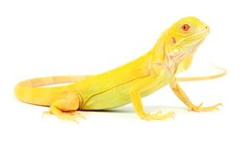
Diet: Iguanas are strict herbivores. Many older literatures will suggest feeding animal protein or even cat food. While some wild iguanas may ingest the occasional insect while eating leaves, it is not a significant portion on their diet. Iguanas that are fed too much animal protein will develop health problems and will die prematurely. A well balanced iguana diet will consist of about 40% to 45% greens (this includes, but is not limited to collard greens, turnip greens, mustard greens, dandelion greens (with flowers), escarole, and/or water cress), 40% to 45% other vegetables (this includes but is not limited to green beans, orange-fleshed squashes (butternut, Kabocha), snap or snow peas, parsnip, asparagus, okra, alfalfa (mature, not sprouts), onions, mushrooms, bell peppers, sweet potato, zucchini, yellow squash, and/or carrots), 10% or less of fruits (including, but not limited to Figs (raw or dried), blackberries, strawberries, raspberries, grapes, mango, melon (cantaloupe, honeydew, watermelon), papaya, banana, and/or apple), and less than 5% of other grains or commercial diets. Iguanas should never be rhubarb as it is toxic. Certain lettuces such as iceberg, romaine, and Boston butter lack sufficient nutrients and should only be fed occasionally. Acidic fruits (citrus, tomatoes, kiwi, pineapples, etc.) should also be only fed occasionally as well. Tofu can be occasionally offered as well for supplemental protein, though if too much is given it can lead to long term health issues. Wild plants and flowers are not recommended since they may be toxic to your iguana or may contain pesticides that could be toxic as well.
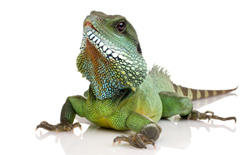
Maintenance: Cleanliness of the enclosure is essential. Waste products should be removed daily and the enclosure should be thoroughly cleaned and disinfected regularly. A 5% bleach solution provides an excellent disinfectant. Be sure to thoroughly rinse the solution from the enclosure before placing the iguana back in. Fresh water should also be offered at all times. Always wash your hands after handling your iguana or any of your iguana\'s cage accessories.